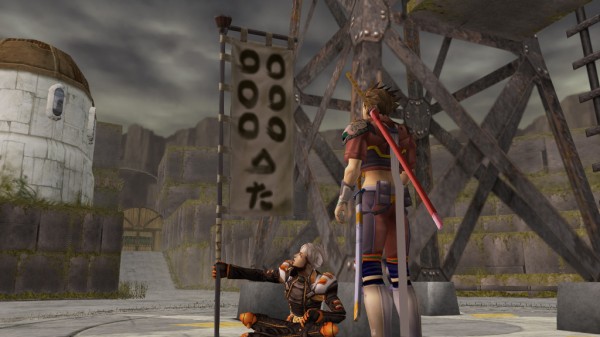
A little over ten years ago, the first and so far only video game directly based on an Akira Kurosawa film was released. As its name suggests, Seven Samurai 20XX takes Kurosawa’s 1954 Seven Samurai as a starting point and adapts it to a futuristic 21st century setting. The game was a Kurosawa Production licensed title and it was made to coincide with the film’s 50th anniversary, which was also celebrated with a fairly similarly themed animated series Samurai 7. Kurosawa Production was clearly trying to reach out to younger audiences.
The team behind Seven Samurai 20XX was fairly impressive. Developed in Japan by the veteran studios Dimps and Polygon Magic, the PlayStation 2 exclusive hack-and-slash action adventure featured music by the legendary Ryūichi Sakamoto and character designs by the similarly legendary French artist Moebius.
Yet, at the time of its released the game was met with fairly poor and often pretty openly hostile reviews. Here are some of the things that were said about the game at the time (all review quotes come from Metacritic):
“When you’re not being blazingly bored by the fighting, you’ll be frustrated by the linearity of the thing.” (GameSpy)
“Offers nothing but mindless button-mashing, boring level design, and horrible pacing.” (Game Informer)
“If it had a deeper combo system, or extra weapons, or extra characters, it’d be worth checking out. It doesn’t, so it isn’t.” (Game Over Online)
“Much like riding an elevator with a bunch of retards” (Stuff)
“To put it bluntly, you’ll lose all honor as a samurai if you attempt to swing this unsharpened sword that shamelessly uses the Seven Samurai name.” (GamePro)
“I expect ‘Seven Samurai’ Director Akira Kurosawa’s grave is equipped with some sort of industrial centrifuge to accommodate the amount of spinning he’s doing right about now.” (Electronic Gaming Monthly)
“With so many liberties taken with the story, we expected to see Godzilla.” (Playboy)
“This game is so bad that it’s insulting to both the talent behind it and the poor bastards who’ll end up playing it.” (GMR Magazine)
“Instead of buying this garbage, give the original film a purchase.” (Thunderbolt)
With all this in mind, I decided to finally see for myself what the game is about and got hold of a copy. Here are my thoughts. Plenty of spoilers follow.
Story

Seven Samurai 20XX starts with a young and futuristic samurai called Natoe — the sole player character throughout the story — walking through a similarly futuristic city when he is suddenly assaulted by a group of cyborgs, robots and mutants collectively called “humanoids”. They are the villains of the story and roughly equivalent to the bandits in the original film. A little later on Natoe encounters a group of humans who ask him for help in protecting their village from an impending humanoid attack. These, of course, are the farmers from the original film.
Natoe initially declines the offer but later meets the group again with some more familiar faces, including a wise older samurai called Kanbei. They now get Natoe to join the group, and some more time is spent recruiting the remaining samurai, a task which requires plenty of swordplay from Natoe. Once all seven are together, the group travels to the village, fighting a handful of foes on the way and having a brief encounter with a winged woman who later turns out to be the main villain. Once they reach the village they receive a cold welcome, almost exactly as in the film. But the samurai quickly win over the trust of if not the villagers at least the village elder, and so they start training the populace, a task which the player has no influence over.
The feeling of trust isn’t mutual, however, as the samurai quickly find out that they haven’t been told the real reason why the humanoids are planning an attack on the village. It turns out that the power and balance between the humans and the humanoids in this world comes from a young girl, the Child of Heaven, who has recently gone missing. She and her sacred jewel are now being held by the villagers, who were planning to ransom the authorities for her safe return, only to find out that they had bitten off way more than they can chew.
Even then, the samurai decide to help. But since more help is needed, Natoe is tasked to find an eighth samurai, and so the player character leaves the village. The journey doesn’t go exactly as planned, but after plenty of fighting, Natoe finds not only a female samurai to fight alongside him but also a somewhat Obi-Wan Kenobi type of a character who briefly prophecies about his past and the future.
Natoe and the new recruit return to the village just in time for a small attack, which is easily blocked thanks to the samurai’s preparations. A captured humanoid reveals the location of one of the humanoids’ strongholds and the samurai decide to carry out a pre-emptive strike, with Natoe and two other samurai leaving to infiltrate the humanoid fortress that has been used for biological experiments on captured humans. They are accompanied by one of the villagers who, as you may have guessed if you remember the storyline in Seven Samurai, ends up meeting his wife, or what is left of her anyway.
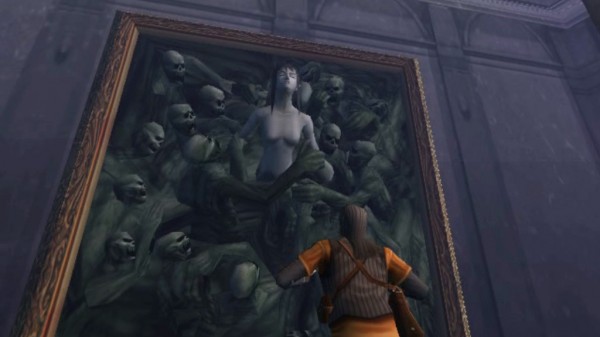
The samurai manage to destroy the fortress but only with one of them dying. More bad news follows as they return to the village, for the humanoids are just about to attack. The samurai go on the defensive and manage to protect the village, but again one samurai has to sacrifice his life — literally, as a walking bomb. Natoe, meanwhile, confronts the main villain but only manages to kill her generals before she flees the scene.
With the humanoids defeated and the village now more or less safe, the worst isn’t over yet. The humanoids have kidnapped one of Natoe’s group, his childhood friend Jodie, apparently meaning to use her as a replacement for the Child of Heaven. Natoe departs immediately with the female samurai, and the two head over to a gigantic facility called the Library of Avalon. Fighting their way through enemies and books, the two ultimately come across a mysterious humanoid who turns into a hugely powerful angel-like creature for the game’s final battle. Despite his opponent’s powers, Natoe emerges victorious and manages to save Jodie.
But as Natoe and Jodie return to the village, they are attacked by the main villain who is still after the Child of Heaven. The fight goes south pretty quickly and Natoe, Jodie and the villain all lose their lives in one final battle — one that the player has no control over.
A final scene follows, with only Kanbei and another samurai having survived the story. As they look at the mounds representing the samurai’s graves, Kanbei summarises the situation: “So again we are defeated. The farmers have won. Not us.” End credits.

All in all, the story of Seven Samurai 20XX is an interesting mixture of iconic scenes from the original film shuffled together with original content. Unfortunately, as so often when Kurosawa’s storylines are reimagined by others, the resulting work lacks balance, with the execution of the story falling short of the original.
In terms of narration, the biggest problem in Seven Samurai 20XX is that the story never really connects with the gameplay in any meaningful way. This is a common problem with many cinematic games, but with Seven Samurai 20XX it is especially pronounced. You could remove all the cut scenes from the game and the gameplay wouldn’t really be affected in any way, while the removed cut scenes would more or less function as a complete story on their own. This is just lazy design.
The cut scene sequences, the longest of which run for over 10 minutes, are quite funny, although often in unintentional ways. I don’t know whether the original Japanese had a different tone, but the writing of the English version would seem to suggest the story’s target audience to be around 10-year-olds. Below is an excellent example from very early on in the game, when Natoe first meets the villagers. The video should start at 2 minutes 32 seconds, and if you watch until 4 minutes 35 seconds, you get a fairly good overview of the game.
The comic writing does, however, have its moments. There is a sequence about half-way through the game that I was particularly fond of. It appeared to have absolutely nothing to do with the story and featured two skateboarding hip hop kids — think of a mixture of Kris Kross from the early 90s and the current Irish pop duo Jedward — whose purpose remains a mystery to me, but whom Natoe nevertheless ends up fighting.
The problem with the story goes beyond execution, however. Although the game largely follows the Seven Samurai storyline, it lacks its spirit. While the film for instance examines group dynamics and what happens when a number of talented individuals come together for a shared purpose, the game has absolutely no feeling of community to it. You control a single character, Natoe, who handles all of the fights. Although there are other fighters around, none of them actively help you as they always conveniently have to be somewhere else when battles begin. Similarly, while the film Seven Samurai celebrates intelligence and its characters fight with precision and economy with every single life on both sides accounted for, the action in Seven Samurai 20XX is wasteful, enemies endless, and the swordplay far from sparse.
In fact, although Seven Samurai would actually be a fairly interesting basis for a strategy game of some sorts, none of that side of the film exists in the game. Natoe spends more time outside of the village than in it, and has next to nothing to do with the defensive preparations. The result is a fairly straightforward tunnel run that waits for you to proceed from point A to point B in order to trigger a cut scene that moves the story forward.
Which brings us to gameplay.
Gameplay and design
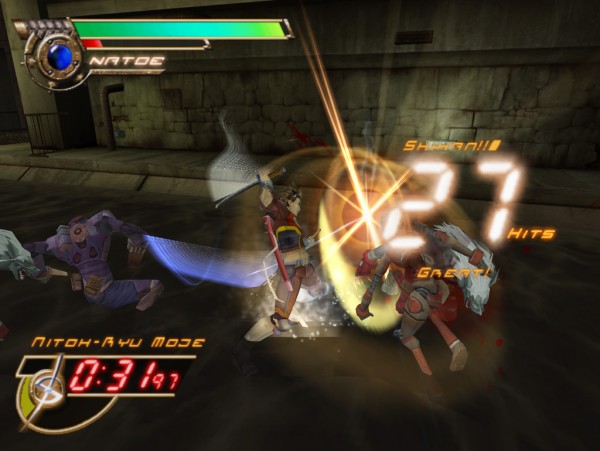
At the time of its release, in addition to occasional technical issues, Seven Samurai 20XX was largely criticised for its repetitive and unimaginative gameplay. I can definitely see why.
There are two types of battles in the game: ones which have you battle numerous weaker enemies and ones that are boss fights where you typically fight a single opponent. On the surface, the enemies are fairly varied. However, although the game includes a basic combo system, in reality all the player needs to do in all but two fights is activate Natoe’s two sword skill and repeatedly press the attack and guard buttons until the skill timer goes to zero, then dodge the enemies until the skill becomes available again. Rinse and repeat. The two fights which are exceptions to this basic pattern are such only because in those the player actually needs to aim the attacks to specific targets.
This lack of any sort of fighting strategy is coupled with a very tight camera that you cannot really control, making it impossible to see anything but the closes enemies and therefore further preventing any sort of real tactical gameplay. As a result, the gameplay is indeed hugely repetitive and there are sections of the game which you can literally play through with your eyes closed. This is perhaps surprising, considering that the co-developer Dimps later worked on the much praised 2008 fighting game Street Fighter IV, showing that they could actually get fighting mechanisms right.
Having said that, the descriptive word here would be “competent” rather than “terrible”. The hack-and-slash mechanism could definitely be worse, and as someone who isn’t particularly fond of the genre to begin with, hacking my way through endless waves of enemies was in some ways relaxing. Which is to say, at least the game was very easy and therefore never frustrating.
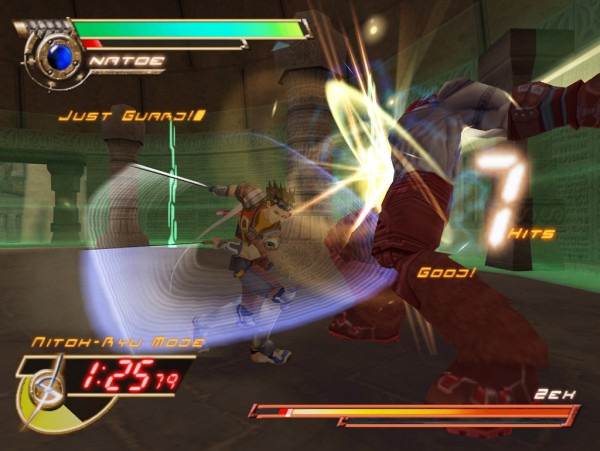
Speaking of frustrating though, what ultimately really brings down the game and story design is the ending, which fails the player in two ways: it forces the death of the main character and gives the player no control over the proceedings. To play through the whole game only to watch a long cut scene where not only your character but also the character that you just spent a considerable amount of time and energy saving die, is a hugely anticlimactic way to end the story. It robs the player any feeling of accomplishment and feels like a very clumsy attempt at mimicking the original film’s sombre ending.
The uninspiring (if competent) gameplay is coupled with rather bland and repetitive level design, which only really picks up towards the end of the game. As was mentioned earlier, the game is a bit of a tunnel run and although the city and the village function as something like hub worlds, they are largely empty and uninteresting. In terms of game design, these areas are also quite poorly put together and therefore confusing. Having said that, the scale of the playable parts of the city is nevertheless somewhat impressive and there is definitely something of a Knights of the Old Republic vibe to some of the architecture. Unfortunately, unlike with the said Bioware title, while you can talk to random people, there are no branching conversations and it seems like no one really has anything interesting to say, anyway. Some of it didn’t even seem to make much sense. The end result feels very empty and hollow.

Where the game does excel is character design. Especially after the first third of the game, both the heroes and the villains are visually interesting and fun to look at. There is quite a bit of creativity there and it is amazing what has been realised with the available technology. The only major negative here is the majority of female characters who, like so often in video games, are prime examples of a stereotypical 13-year-old’s wet dream.
As for the music, apart from the opening theme track and a couple of ambient tracks along the way, the game’s soundtrack is surprisingly forgettable considering Ryūichi Sakamoto’s involvement.
Closing thoughts
At one point in the game, the main character is asked the following question: “Is there a reason you fight, or is it just the only thing that you know? What is it that you are striving for?”
This is the question that I would like to ask the game as well. While it is a more or less competent hack-and-slasher, it is also quite boring and very one-dimensional. Neither are qualities that one wants to aim at when making a game. It is unfortunate that Seven Samurai 20XX has not gone the extra mile, for in its released version it is a solid if uninspiring base on which a far more interesting, challenging and enjoyable game could have been made, had the developers taken some extra time to tweak the story, the world and the fighting mechanics.
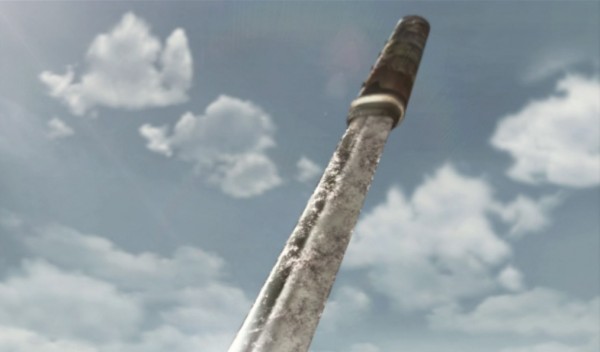
Seven Samurai 20XX is not a particularly long game — according to the game’s built-in timer, it took me 5 hours 1 minute and 37 seconds to finish — but it is not really worth your time as anything else than a Kurosawa curiosity. And even then, if you want to play a vaguely Akira Kurosawa inspired video game, the 1988 Commodore 64 title Usagi Yojimbo, based on the comics of the same name, would not only be a more interesting choice but also has a better integration of story and gameplay. Alternatively, you could try out the recent free game Tokyo 1923 or just decide to wait for the upcoming Ni-Oh, which has been in production for over a decade now and may or may not still be based on Kurosawa’s unfilmed screenplay the way it was originally marketed.
Seven Samurai 20XX isn’t quite as bad as launch time reviews make it to be, but it isn’t particularly good either. Apart from the character design, pretty much everything in the game screams average. It just never really excites. It is competent but ultimately uninteresting, a passable way to kill time. And that, certainly, is its biggest fault, considering the title which it carries.






hi there 🙂
good review! i agree with most of what you wrote. it’s def a flawed game but it’s an old childhood fav of mine so i love it regardless. the chances are slim to none, but i really hope it gets a remake or something one day, with an improved story and all
anyway, it made me happy to find someone reviewing an old game like this! esp this one, because its kind of obscure and niche, so you don’t find people talking about it a lot these days. i am very alone here in the seven samurai 20xx fandom 😉